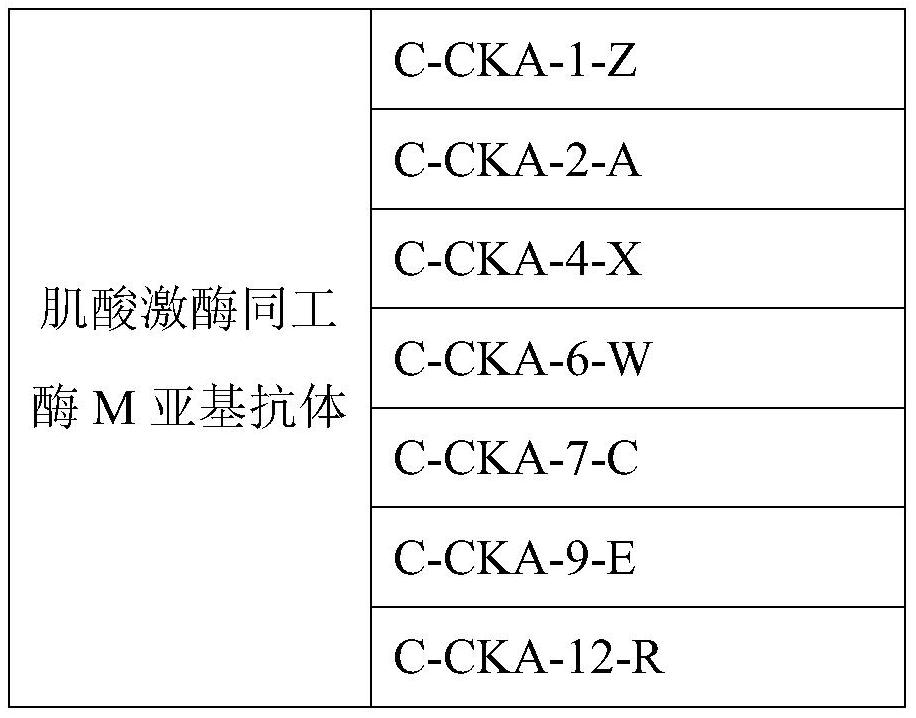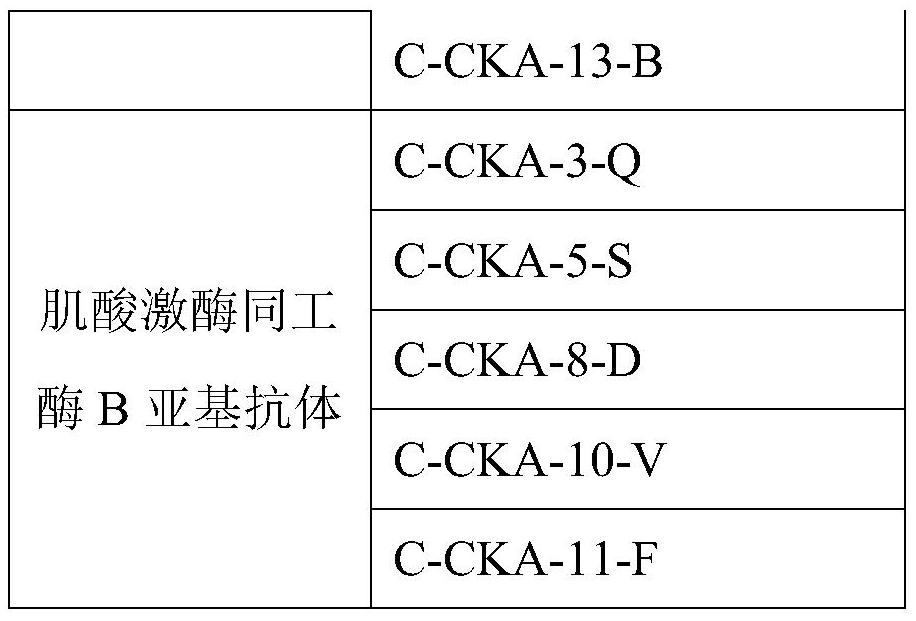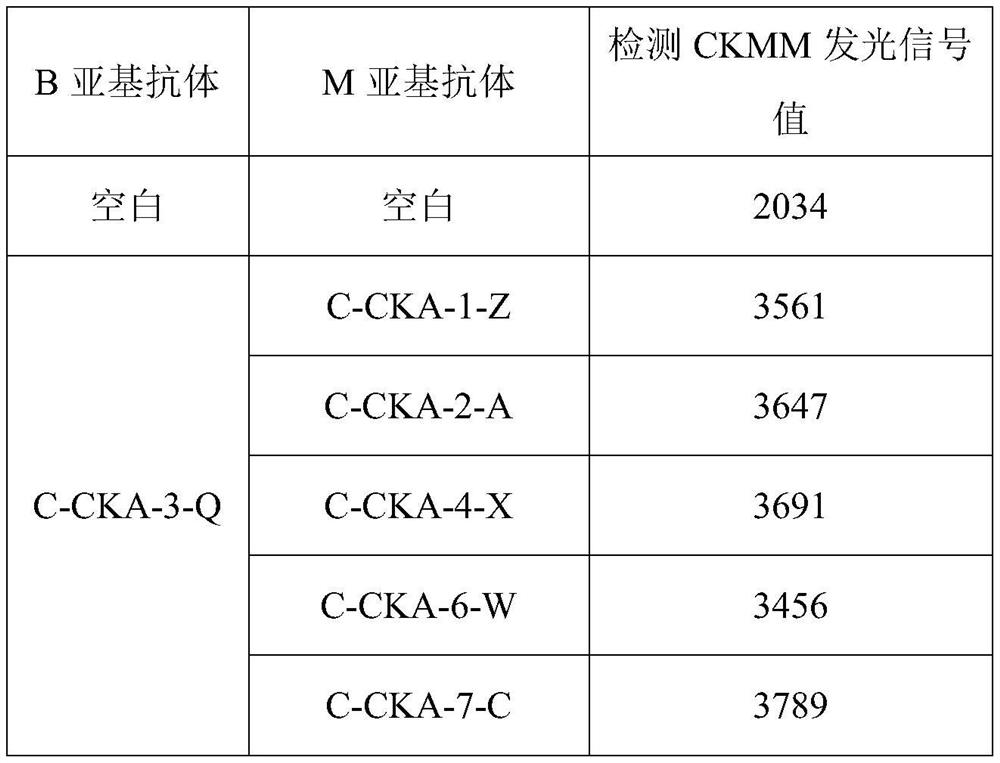A kit for specific detection of creatine kinase isozyme
A creatine kinase and isoenzyme technology, applied in the field of creatine kinase detection, can solve the problems of low detection linear range and low detection specificity of a creatine kinase isoenzyme detection kit, and achieve high linearity and HOOK resistance. , Improve the detection linear range, the effect of short detection time
- Summary
- Abstract
- Description
- Claims
- Application Information
AI Technical Summary
Problems solved by technology
Method used
Image
Examples
preparation example 1
[0040] Preparation of Reagent RM
[0041] (1) Use a pipette gun to measure 1.5mL magnetic microspheres (10% solid content) into the corresponding centrifuge tube, magnetically absorb it on the magnetic stand for 3min, discard the supernatant, add 5mL coating buffer, and vortex to mix 10 seconds, then magnetic suction for 3 minutes, discard the supernatant, add 4mL coating buffer; the coating buffer is 50mmol / L phosphate buffer;
[0042] (2) Add 2mg of CKMM coating antibody, vortex for 10s, place in a shaker and mix in a 37°C drying oven for 4h (shaker parameters: 1000rpm);
[0043] (3) Add 1mL of blocking solution, place in a shaker and mix in a 37°C drying oven for 4h (shaker parameters: 1000rpm);
[0044] (4) Magnetic suction for 3 minutes, remove the supernatant, use 10mL magnetic bead preservation buffer and invert repeatedly 20 times, mix well;
[0045] The components of the magnetic bead preservation buffer include 20mmol / L Tris buffer, 0.1% BSA, 0.1% Tween20, 0.1% polye...
preparation example 2
[0048] Preparation of Reagent RM
[0049] (1) Use a pipette gun to measure 1.5mL magnetic microspheres (10% solid content) into the corresponding centrifuge tube, magnetically absorb it on the magnetic stand for 3min, discard the supernatant, add 5mL coating buffer, and vortex to mix 10 seconds, then magnetic suction for 3 minutes, discard the supernatant, add 4mL coating buffer; the coating buffer is 50mmol / L phosphate buffer;
[0050] (2) Add 2mg of CKMM coating antibody, vortex for 10s, place in a shaker and mix in a 37°C drying oven for 4h (shaker parameters: 1000rpm);
[0051] (3) Add 1mL of blocking solution, place in a shaker and mix in a 37°C drying oven for 4h (shaker parameter: 1000rpm);
[0052] (4) Magnetic suction for 3 minutes, remove the supernatant, use 10mL magnetic bead preservation buffer and invert repeatedly 20 times, mix well;
[0053] The components of the magnetic bead preservation buffer include 20mmol / L Tris buffer, 0.1% BSA, 0.1% Tween20, 0.1% poly...
preparation example 3
[0056] Preparation of Reagent R1
[0057] (1) Take 1 mg of CKMM-labeled antibody, add 1 mg of EDC (EDC is prepared with water to 10 mg / mL, ready-to-use), and stand at room temperature for 20 minutes;
[0058] (2) Take 2mg of alkaline phosphatase and add appropriate amount of purified water to dilute to 1mg / mL; add purified water (mL)=2-(2 / C), add alkaline phosphatase volume (mL)=2 / C, wherein, C (mg / mL) is the concentration of alkaline phosphatase;
[0059] (3) Mix the mixture obtained in step (1) and the mixture obtained in step (2), and leave to react at room temperature for 60 minutes;
[0060] (4) Place the mixture obtained after standing in step (3) into a dialysis bag with a pore size of 7K, and place it in 500 mL of enzyme marker storage buffer, place it at 2-8°C for 4 hours for dialysis, and repeat this step twice;
[0061] The components of the enzyme marker preservation buffer include 25mmol / L Tris buffer, 0.1% BSA, 0.1% Tween20, 0.1% polyethylene glycol 6000, 0.01%...
PUM
 Login to View More
Login to View More Abstract
Description
Claims
Application Information
 Login to View More
Login to View More - R&D
- Intellectual Property
- Life Sciences
- Materials
- Tech Scout
- Unparalleled Data Quality
- Higher Quality Content
- 60% Fewer Hallucinations
Browse by: Latest US Patents, China's latest patents, Technical Efficacy Thesaurus, Application Domain, Technology Topic, Popular Technical Reports.
© 2025 PatSnap. All rights reserved.Legal|Privacy policy|Modern Slavery Act Transparency Statement|Sitemap|About US| Contact US: help@patsnap.com



